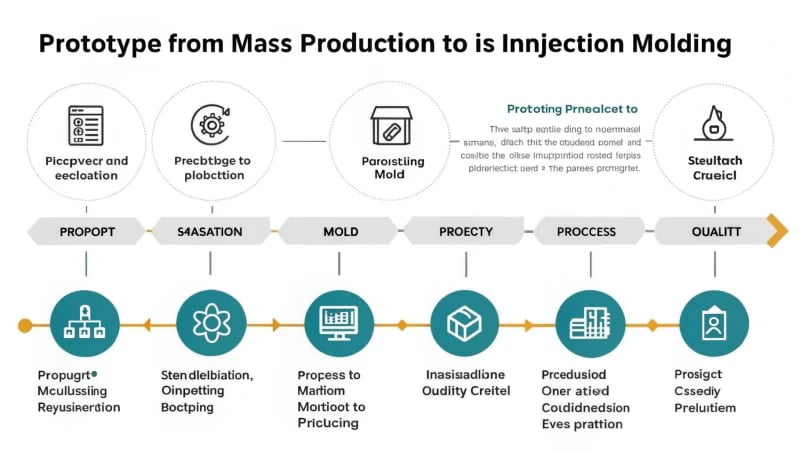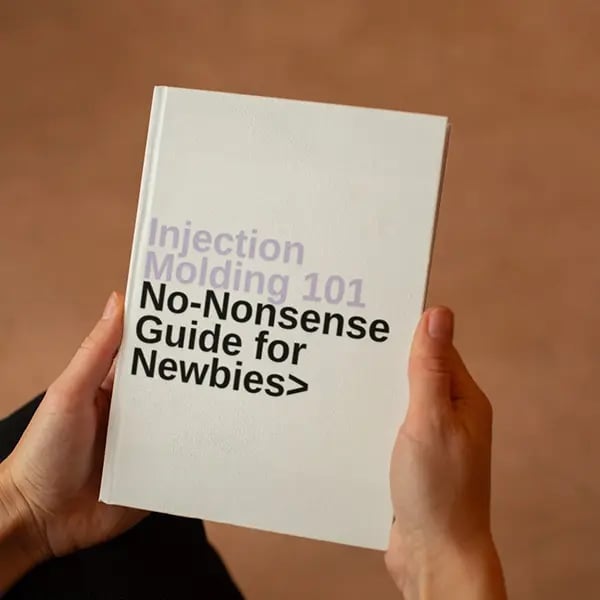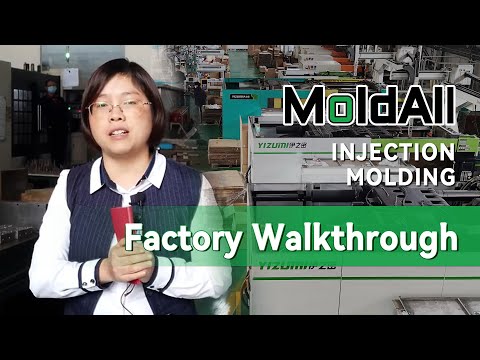
Ever faced the daunting task of scaling up production in injection molding? I have, and it’s a journey worth sharing.
To transition from prototype to mass production in injection molding, optimize prototypes, refine molds, standardize processes, establish quality controls, and prepare equipment and personnel for large-scale production.
As someone who has navigated these waters before, let me tell you—it’s all about breaking down the process into manageable steps. Evaluating the prototype is your starting point. I remember the first time I had to test a plastic gear prototype; checking its strength and durability was crucial. Once you’re sure the design holds up, it’s time to optimize the mold. This means diving into the nitty-gritty details like adjusting cooling channels if you notice any warping. Then comes standardizing your process parameters, which might sound tedious, but believe me, it saves you headaches later on. Setting up a robust quality control system is next. I’ve learned that real-time monitoring can catch issues before they escalate. Finally, ensuring your equipment is up to snuff and your team is well-trained rounds out the preparation for mass production. Each of these steps brings you closer to a seamless transition.
Prototype evaluation is the first step in transitioning to mass production.True
Evaluating prototypes ensures they meet design specifications before scaling.
Quality control is unnecessary in mass production of injection molding.False
Quality control is crucial to maintain standards and reduce defects.
- 1. How Can You Evaluate and Optimize a Prototype for Mass Production?
- 2. What Are the Best Practices for Mold Optimization and Verification?
- 3. How Can Process Parameters Be Determined and Standardized Effectively?
- 4. What Quality Control Systems Should Be Established for Mass Production?
- 5. How can I efficiently select and configure production equipment?
- 6. Why is staff training crucial for successful mass production?
- 7. Conclusion
How Can You Evaluate and Optimize a Prototype for Mass Production?
I remember my first prototype like it was yesterday. Navigating the journey to mass production felt like solving a giant puzzle, but I discovered it’s all about testing and tweaking every little piece.
Evaluate and optimize a prototype by testing functionality, performance, and aesthetics. Make improvements via mold adjustments, process parameter optimization, and a robust quality control system for successful mass production.

Function and Performance Evaluation
Every time I embark on a new project, I find myself delving into function and performance evaluation like a detective on a mission. Before diving into mass production, perform comprehensive functional tests1 on the prototype. For example, if the prototype is an injection molded plastic gear, verify that it meets transmission accuracy and load-bearing capacity requirements.
Assess its physical properties such as strength, hardness, and toughness, alongside chemical properties like corrosion resistance. If deficiencies are identified, consider altering material selection or modifying structural design.
Example Table: Function Evaluation Checklist
| Property | Test Method | Acceptable Range |
|---|---|---|
| Transmission | Torque Measurement | 0.5-1 Nm |
| Load-bearing | Load Test | 50-100 kg |
| Corrosion | Salt Spray Test | <5% Degradation |
Dimensional Accuracy and Appearance Quality
Dimensional accuracy is like the silent hero of product design. Ensuring dimensional accuracy is crucial. Measure dimensions to check compliance with design tolerances. If deviations occur, analyze potential causes such as mold errors or injection molding shrinkage. Adjust mold size and optimize process parameters if necessary.
Evaluate the appearance quality by checking for surface roughness and defects like flash and bubbles. Improve appearance quality by processing the mold surface or optimizing the filling speed.
Mold Optimization and Verification
Improving molds felt like an art form to me. Enhance mold design based on prototype production experiences2. From adding ejector pins to redesigning cooling systems, each step was essential for stable production.
Conduct mold trials to ensure the refined mold consistently produces quality products. Examine mold actions and stability throughout this stage.
Process Parameter Optimization
Refining process parameters became an exciting experiment. Further refine injection molding process parameters using methods such as Design of Experiments (DOE). Investigate variables like temperature and pressure to find the perfect balance that enhances product quality.
Standardize these parameters into detailed process documents3, including machine settings and quality standards.
Quality Control System Establishment
Creating a quality control plan felt like building a safety net for mass production. This should encompass raw material inspection, process monitoring, and finished product checks.
Implement a traceability system helped me quickly resolve any issues that arose, ensuring each batch met high standards.
Example Table: Quality Control Plan Overview
| Stage | Control Method | Frequency |
|---|---|---|
| Raw Material | Sampling Inspection | Every Batch |
| Process | Real-time Monitoring | Continuous |
| Finished Product | Full/Sample Inspection | Every Batch |
Equipment and Personnel Preparation
Selecting the right equipment was another crucial task based on batch size and product requirements. Ensure all machines are maintained according to process documents; operators well-trained in machine operation techniques is essential for smooth production.
Regular skill assessments kept everyone sharp with latest technologies ensuring smooth mass production progression without compromising on quality.
Functional tests are unnecessary before mass production.False
Functional tests ensure the prototype meets performance criteria, crucial before mass production.
Mold optimization can improve product quality.True
Refining mold design enhances demolding and stability, improving quality.
What Are the Best Practices for Mold Optimization and Verification?
Hey there! Ever found yourself knee-deep in the world of injection molding, trying to get things just right?
To optimize and verify molds effectively, conduct prototype evaluations, adjust designs, refine process parameters, and establish a strong quality control system to ensure efficient production and high-quality injection molding.

Prototype Evaluation and Optimization Stage
I remember the first time I had to tackle mold optimization. It felt like solving a puzzle with a million pieces, each one vital for perfecting the final product. Effective mold optimization begins with evaluating and optimizing prototypes. Testing those prototypes isn’t just about checking a box; it’s like ensuring your favorite recipe tastes just right before serving it to guests.
When I evaluated prototypes, I focused on function and performance. For example, I’d often find myself imagining a plastic gear in action, questioning if it could handle the load or maintain its accuracy. The trick was to adjust either the materials or the process itself based on results to enhance mechanical performance4. Once, I had to swap out a material because the gear couldn’t bear the strain; that was a real eye-opener.
Dimensional Accuracy
Getting dimensions right is like hitting the bullseye with a dart—tricky but rewarding when you nail it. Measure dimensions accurately to meet design tolerances. If things went off course, I’d dive into the details, investigating causes like manufacturing errors and tweaking mold sizes or adjusting cooling times until everything lined up perfectly.
Mold Improvement and Adjustment
Next up was mold improvement. Identify issues during prototype production and improve molds accordingly. Imagine trying to ease dough from a tricky pan; that’s how it felt when demolding was tough. Adding ejector pins was like greasing that pan, making everything smoother. Uneven cooling was another hurdle, one that sometimes required redesigning cooling systems if deformation occurred.
Mold Trial Verification
Running mold trials felt like rehearsing for a big show. Conduct trials to verify improvements by monitoring mold actions, process stability, and product quality during trials. Each trial was an opportunity to observe and refine, ensuring every piece performed as expected. Perform multiple tests until products were as consistent as my morning coffee.
Process Parameter Optimization
Fine-tuning parameters was an art form in itself—balancing temperature, pressure, speed, and holding time using experimental design methods like DOE—like a maestro conducting an orchestra.
| Parameter | Optimal Range | Example Method |
|---|---|---|
| Temperature | 180-220°C | DOE |
| Pressure | 100-150 MPa | Orthogonal Test |
I used methods like DOE to find that sweet spot where everything came together beautifully. Documenting these parameters provided clear guidance for future production runs, ensuring consistency and quality.
Quality Control System Establishment
Setting up a quality control system was about ensuring peace of mind—knowing that each product met high standards from start to finish. Develop quality control plans covering raw material inspection, process monitoring, and finished product inspection with traceability systems in place for batch identification traceability system5, recording raw material information and process parameters so any hiccup could be quickly addressed—much like knowing exactly which ingredient needs adjusting in a less-than-perfect dish.
Equipment and Personnel Preparation
Choosing the right equipment was like picking the best tools for a DIY project—essential for getting the job done efficiently based on production scale and requirements. Configure auxiliary equipment like dryers or robots to enhance efficiency while training operators felt akin to teaching someone how to perfect their craft; it required patience and diligence but ensured smooth production processes through regular skill assessments keeping skills sharp meant we stayed ahead of the curve ready to tackle any challenge that came our way.
Prototype testing ensures mold function and performance.True
Testing prototypes helps identify issues in mold design and function.
Orthogonal tests are used for optimal parameter combinations.True
Orthogonal tests help find the best settings for process parameters.
How Can Process Parameters Be Determined and Standardized Effectively?
Ever wondered how manufacturers nail the consistency and quality of their products? It all boils down to mastering process parameters. Let me take you on a journey through my experiences in making this magic happen.
To determine and standardize process parameters, use prototype testing, mold optimization, documentation, and quality control, ensuring product consistency and efficiency.

Evaluation and Optimization in Prototyping
The prototype evaluation stage begins with comprehensive testing to ensure the prototype meets design requirements. Tests include functional, performance, and physical assessments. For instance, injection-molded plastic gears must demonstrate transmission accuracy6, load-bearing capacity, and appropriate chemical properties.
Once testing is completed, design and process optimizations are essential. If performance issues arise, consider if improper material selection or structural design are factors. Adjustments might include changing the plastic material or altering injection molding parameters7 like holding time and pressure.
Dimensional Accuracy and Appearance Quality
Ensuring dimensional accuracy involves measuring the prototype against design tolerances. Deviations might result from mold manufacturing errors or inappropriate injection molding shrinkage control. To address this, adjust mold size or optimize parameters like cooling time and temperature.
Appearance quality assessment focuses on surface aspects like roughness and glossiness. Address defects by processing the mold surface or optimizing filling speed8 and exhaust processes.
| Quality Factors | Considerations |
|---|---|
| Transmission Accuracy | Load-bearing Capacity |
| Surface Roughness | Glossiness |
Mold Optimization and Verification
In the mold optimization stage, enhancements are based on prototype production insights. For example, if demolding is challenging, increase demolding mechanisms or redesign cooling systems for uniformity. Conduct mold trials to ensure stability and quality consistency.
Process Parameter Optimization
With a refined mold, optimize injection molding parameters further. Utilize experimental designs like DOE to study effects of temperature and pressure9 on product quality. Determine the best parameter combinations through systematic trials.
Document standardized parameters thoroughly, covering machine model settings, mold installation requirements, and material specifications. Clear documentation facilitates efficient mass production operations.
- Parameter Documentation Essentials
- Injection machine settings
- Mold installation guidelines
- Raw material specs
- Quality standards
Establishing a Quality Control System
Develop a comprehensive quality control plan for mass production. Outline methods for monitoring raw materials, injection processes, and finished products. Implement real-time monitoring to detect anomalies promptly.
Introduce a traceability system to track each production batch’s details, including raw material sources, mold numbers, and process parameters. This aids in quick issue resolution when quality problems arise.
| Monitoring Aspects | Methods |
|---|---|
| Raw Material Inspection | Process Monitoring |
| Finished Product Checks | Real-time Monitoring |
By adopting these strategies, I’ve seen firsthand how manufacturers can achieve exceptional quality and efficiency in their production processes. It’s a journey that requires attention to detail at every stage but offers rewards well worth it.
Prototype testing includes functional and physical assessments.True
Testing ensures prototypes meet design requirements through comprehensive evaluations.
Mold size adjustments are unnecessary for dimensional accuracy.False
Adjusting mold size can correct deviations from design tolerances.
What Quality Control Systems Should Be Established for Mass Production?
Navigating the world of mass production can feel like a maze, especially when it comes to maintaining quality. How do we ensure every product meets high standards?
Effective quality control systems for mass production should include prototype evaluation, mold optimization, process parameter standardization, and a detailed quality plan to ensure consistent product quality and enhanced efficiency.

I’ve always found that diving into mass production feels like embarking on an exciting journey. You start with a vision and then watch it come to life piece by piece. But ensuring that every part of this journey results in a top-notch product? That’s where the real challenge lies.
Prototype Evaluation and Optimization
Whenever I’m in the prototyping stage, it feels like being in a lab filled with endless possibilities. Testing prototypes isn’t just about ticking boxes; it’s about nurturing your creation until it’s ready for the big stage. I remember testing a plastic gear prototype and realizing it needed more than just functional tweaks. We had to rethink materials to handle stress better. Maybe you’ve had a similar "aha" moment when a prototype wasn’t quite up to scratch and needed that extra push.
A table could summarize these steps:
| Stage | Activity |
|---|---|
| Function Testing | Check transmission accuracy |
| Material Optimization | Adjust materials based on test results |
Prototype dimensions, surface quality checks—these are not just technical tasks; they’re steps to ensure our creation can stand proudly in the market.
Mold Optimization and Verification
Improving molds based on initial feedback is akin to refining a recipe until it tastes just right. I recall a time when adding ejector pins made all the difference for a stubborn prototype. Those small changes can transform challenges into triumphs.
Conducting mold trials ensures that the improved mold produces quality products consistently.
| Problem | Solution |
|---|---|
| Uneven Cooling | Redesign cooling system |
| Demolding Issues | Increase ejector mechanisms |
Process Parameter Standardization
Finding the perfect parameters is like tuning an instrument; it takes patience and precision. Whether it’s adjusting temperature or pressure, each tweak brings us closer to harmony—a consistent, quality product every time.
Standardized documents should detail:
- Injection molding machine settings.
- Mold installation requirements.
- Raw material specifications.
Crafting these standardized documents ensures everyone is on the same page, turning chaos into coherence.
Quality Control Plan Formulation
A robust quality control plan is our safety net. It’s about having each batch of raw materials inspected and every finished product scrutinized until it meets our standards.
- Raw Material Inspection: Sample each batch.
- Process Monitoring: Use online equipment for real-time checks.
- Finished Product Inspection: Ensure dimensional accuracy.
establishing a traceability system has saved me from many headaches, providing clarity when things go awry.
injection Molding Machines](PLACEHOLDER_INJMLD001) are areas I continually explore to refine our approach and ensure we’re always ahead of the curve. This process isn’t just about making products; it’s about crafting reliability and excellence every step of the way.
Prototype dimensions are critical for design adherence.True
Measuring prototype dimensions ensures they meet design specifications.
Mold trials are unnecessary in quality control systems.False
Mold trials verify improvements and ensure consistent product quality.
How can I efficiently select and configure production equipment?
Ever felt overwhelmed by the sheer number of choices when selecting production equipment? I have been there too, and it’s all about finding the perfect fit for your unique needs.
Efficiently select and configure production equipment by assessing production needs, evaluating capabilities, and optimizing operational parameters for smooth manufacturing, cost efficiency, and high product quality.

Assessing Production Needs
When I first started in the mold industry, the sheer variety of equipment options was daunting. But over time, I learned that understanding your production needs is key. Picture this: you’re planning to manufacture high-volume plastic parts. It’s like deciding on the right pair of shoes for a marathon; you wouldn’t pick flip-flops, right? Instead, you’d choose robust injection molding machines10 with precise control capabilities to match your production volume and quality requirements.
Evaluating Equipment Capabilities
Evaluating equipment capabilities can feel like navigating a maze, but it’s crucial. Imagine trying to bake a cake without knowing your oven’s settings. Similarly, when selecting equipment, focus on parameters like clamping force and automation features. I once used a handy comparison table11 to visualize which machines fit my needs best. It was a game-changer, helping me see which equipment could handle specific materials efficiently.
| Equipment Feature | Importance Level | Notes |
|---|---|---|
| Clamping Force | High | Essential for mold precision |
| Injection Volume | Medium | Depends on part size |
| Automation Features | High | Increases efficiency |
Optimizing Operational Parameters
Once the right equipment is selected, it’s all about fine-tuning those operational parameters. Think of it like adjusting your car’s seat and mirrors before a long drive—every detail counts for comfort and safety. Experiment with temperature, pressure, and speed settings using methods like experimental design (DOE) to find what works best for you. Regular trial runs12 ensure that stability and consistency are maintained.
Implementing Quality Control Measures
Quality control isn’t just a buzzword; it’s a lifeline for maintaining product standards. Establish a rigorous quality control system with regular maintenance checks and real-time monitoring. It reminds me of setting up checkpoints during a hiking trip—catching deviations early keeps you on track.
Staff Training and Skill Improvement
Finally, never underestimate the power of well-trained operators. I remember when our team upgraded their skills; productivity soared. Invest in training sessions to keep everyone updated on the latest technologies and methods. It’s like giving your team the best gear before a big climb—the right tools make all the difference.
The importance of continuous learning13 cannot be overstated in staying ahead in manufacturing. It’s about constantly sharpening your skills and adapting to new challenges.
High clamping force is crucial for mold precision.True
Clamping force ensures the mold remains closed during injection, critical for precision.
Automation features have low importance in equipment selection.False
Automation features are highly important as they significantly increase production efficiency.
Why is staff training crucial for successful mass production?
Ever wondered why some production lines run like well-oiled machines while others seem stuck in a perpetual traffic jam?
Staff training is crucial for mass production as it enhances efficiency, ensures quality, and fosters innovation by equipping employees to handle complex machinery and processes effectively.

Enhancing Operational Efficiency
I remember the first time I walked into a bustling production floor—it was like stepping into a world of organized chaos. The secret to keeping everything running smoothly? Training. Proper training turns potential confusion into harmony by equipping each team member with the know-how to handle complex machinery efficiently. This not only minimizes downtime but also helps increase throughput. Imagine a scenario where a machine suddenly halts; a well-trained team can quickly troubleshoot and resolve the issue before it spirals into a costly disruption.
| Training Aspect | Benefits |
|---|---|
| Equipment Familiarization | Reduces setup time |
| Process Optimization | Increases productivity |
| Troubleshooting Skills | Minimizes operational delays |
Upholding Quality Standards
Ensuring the highest quality in mass production is akin to walking a tightrope—it requires precision and vigilance. When employees are thoroughly versed in quality control14 procedures, they can catch defects early on, preventing larger issues down the line. I’ve seen firsthand how rigorous quality assurance training can transform a team into a meticulous quality-guarding force.
- Prototype evaluation and optimization: Identifying defects early prevents major issues. This stage involves functional and performance evaluations, ensuring prototypes meet design requirements—critical for parts like plastic gears where accuracy is non-negotiable.
- Regular skill assessments: Keeps the team updated on new quality control technologies.
Fostering Innovation and Adaptability
Training doesn’t just stop at efficiency and quality; it opens the door to innovation. I’ve witnessed how exposure to new techniques can ignite creative problem-solving among teams. It’s like giving them a toolkit to constantly improve processes and reduce costs, all while enhancing product features.
Employees become adept at process innovation15, contributing to cost reductions and product enhancements.
Ensuring Compliance and Safety
Navigating industry regulations can feel like sailing through a storm. Training serves as the compass, guiding employees through compliance with safety protocols and minimizing legal risks. Knowing that everyone is well-versed in safety procedures offers peace of mind, reducing workplace injuries and promoting a safer environment.
Adapting to Technological Advancements
With technology evolving at breakneck speed, staying ahead of the curve is crucial. Training empowers employees to seamlessly integrate new technologies into existing workflows, ensuring the company remains competitive in the ever-changing landscape.
| Technological Training | Advantage |
|---|---|
| Automation Systems | Increases efficiency |
| Advanced Software Tools | Improves process accuracy |
| Emerging Manufacturing Trends | Keeps company competitive |
Building a Cohesive Team
A unified team is the backbone of any successful operation. Through training, individuals learn to work together seamlessly, reducing miscommunication and improving workflow coordination. I’ve seen how team-building exercises during training can foster trust and cooperation, turning colleagues into a cohesive unit ready to tackle any challenge.
Investing in comprehensive staff training doesn’t just elevate current operational capabilities—it builds a resilient workforce poised to meet future challenges in mass production environments. It’s about preparing for today and gearing up for tomorrow.
Training reduces setup time in mass production.True
Proper equipment familiarization allows employees to quickly set up machinery.
Training has no impact on product quality in mass production.False
Quality assurance training helps detect defects early, ensuring high standards.
Conclusion
Transitioning from prototype to mass production in injection molding involves evaluating prototypes, optimizing molds, standardizing processes, establishing quality controls, and preparing equipment and personnel for efficient production.
-
Explore detailed methodologies for performing functional tests on prototypes to ensure they meet design specifications. ↩
-
Discover various techniques to optimize molds for better production efficiency and product quality. ↩
-
Learn how to create comprehensive process documents that standardize production parameters. ↩
-
Explore methods to test mechanical performance in injection molding for improved outcomes. ↩
-
Understand how a traceability system can enhance quality control in manufacturing. ↩
-
Learn how transmission accuracy impacts gear performance and how it can be tested. ↩
-
Discover methods to enhance performance by adjusting injection molding parameters. ↩
-
Explore techniques for improving filling speed to enhance product appearance. ↩
-
Understand how temperature and pressure settings influence product quality. ↩
-
Exploring this will provide insights into how robust machines enhance precision and productivity in manufacturing. ↩
-
A comparison table helps visualize different machine features, aiding in informed decision-making. ↩
-
Understanding trial runs underscores their role in ensuring process stability before full-scale production. ↩
-
Continuous learning keeps you updated with new technologies and methods, fostering innovation. ↩
-
Discover why maintaining high standards of quality assurance is essential for successful mass production. ↩
-
Explore how training encourages employees to innovate and improve manufacturing processes effectively. ↩






